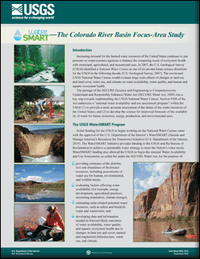Increasing demand for the limited water resources of the United States continues to put pressure on water-resource agencies to balance the competing needs of ecosystem health with municipal, agricultural, and recreational uses. In 2007, the U.S. Geological Survey (USGS) identified a National Water Census as one of six pivotal future science directions for the USGS in the following decade. The envisioned USGS National Water Census would evaluate large-scale effects of changes in land use and land cover, water use, and climate on water availability, water quality, and human and aquatic ecosystem health. The passage of the SECURE (Science and Engineering to Comprehensively Understand and Responsibly Enhance) Water Act in 2009 was a key step towards implementing the USGS National Water Census. Section 9508 of the Act authorizes a "national water availability and use assessment program" within the USGS (1) to provide a more accurate assessment of the status of the water resources of the United States; and (2) to develop the science for improved forecasts of the availability of water for future economic, energy production, and environmental uses. Initial funding for the USGS to begin working on the National Water Census came with the approval of the U.S. Department of the Interior's WaterSMART (Sustain and Manage America's Resources for Tomorrow) Initiative. The WaterSMART Initiative provides funding to the USGS, Bureau of Reclamation, and U.S. Department of Energy to achieve a sustainable water strategy to meet the Nation's water needs. WaterSMART funding also allowed the USGS to begin the national Water Availability and Use Assessment, as called for under the SECURE Water Act.


